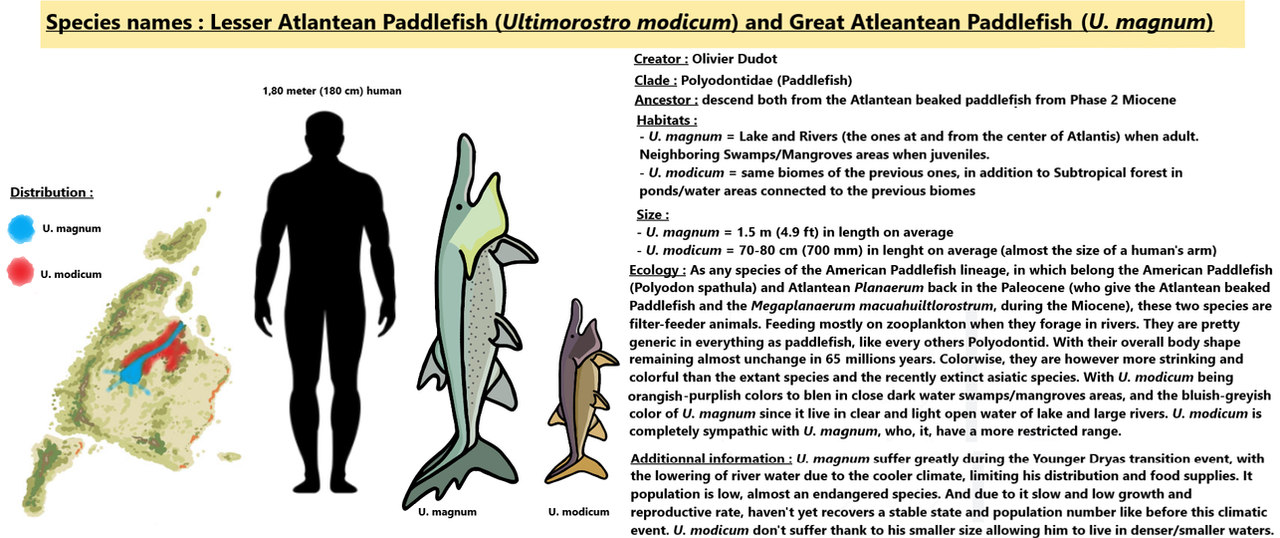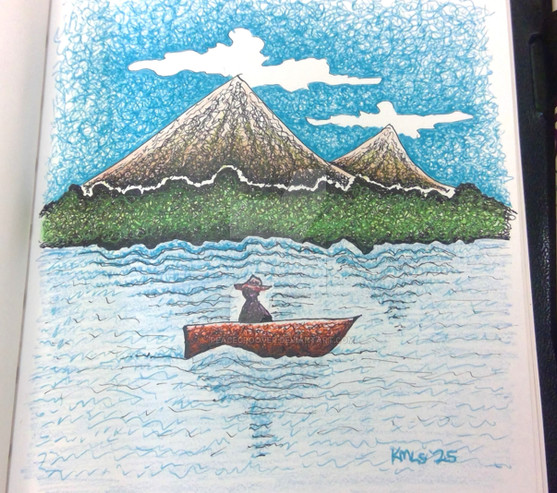HOME | DD
 OlivierDudot — Lesser and Great Atlantean Paddlefish
OlivierDudot — Lesser and Great Atlantean Paddlefish

#paddlefish #atlantisbestiary3 #hyrotrioskjan
Published: 2023-04-07 20:07:52 +0000 UTC; Views: 2154; Favourites: 15; Downloads: 8
Redirect to original
Description
An entry for the Spec Evo community challenge/contest of Hyrotrioskjan/Joschua
Knüppe 's #AtlantisBestiary3 project !
My 4th one !
For this fourth second entry, I choose to made not one, but two species together in total.
And this time, the targeted species are natives animals that descend from a surviving species from the Phase 2 Miocene.
In this case, it two paddlefish species of two notable different sizes who descend from the Miocene Atlantean beaked paddlefish (see « Atlantis Phase 2 » Post, 1st April 2023, third box picture from the top of the chart. Link : www.deviantart.com/hyrotrioskj… ).
I decide to use this Miocene species of fish of Atlantis as common ancestor of both of these species, firstly because it's the only paddlefish species that survived and who could leave a potential legacy (since the second one, called Megaplanaerum macuahuitlorostrum, from the same time died out).
But also because these fish in particular are among my favorite creatures of all this entire Spec Evo community challenge that is Atlantis.
Greatly because because the Paddlefish, aka Polyotondidae, are among the fish and animals groups I like a lot. Not in my top 10 or top 5 favorites, but on which I have a personal touch on them (along with the Chondrichthyes, aka Sharks-Ghost sharks-Rays, the Cœlacanthes, Sturgeons, Lampreys, Bichirs fish, Lungfish, Piranhas, Pacu, Pike, Barracuda, the Mudskippers fish, Swordfish, the extinct Placoderms, the extinct Tristichopterids like the famous Hyneria, etc…).
And since the recently extinct Chinese Paddlefish, Psephurus gladius (last sight at 2003, declared offcially as extinct at 2019), who joined the sad list of the "Historical Extinct Species" (category which include every species who became entirely extinct during the Holocene due to human’s activity), obtained a lot a recognition and publicity (especially online) all around the world since then, and have become a famous example/model in itself like the Dodo, Great Auk, Quagga and Thylacine, I decide to made piece in the honor of his family.
A piece who I hope can act as a tribute to this not well-know by the overall public yet fascinating and marvelous family of primitive fish that noneless are still present on Earth back to the Late Cretaceous, who survived the great K-T Extinction event between this latter era and the Paleocene, and remained almost completely unchange to our days.
The results are the following species :
* The Great Atlantean Paddlefish (Ultimorostro magnum) ;
The biggest species of Paddlefish of Atlantis, who descends from the Miocene Atlantean beaked Paddlefish who lived at least there almost 6 mya years ago (during the Late Miocene) and a little before.
It’s a large species of fish, one of the biggest of the island, and the biggest species in modern times (after the extinction of the Chinese Paddlefish who was bigger than him at adulthood), ranging up to 1,5 meter (4.9 ft) in lenght on average (almost the size of a adult man), but bigger, older, specimens (usually females) also exist. It weigh up to 27 kg (60 lb), see upper in older specimens.
This measurements are similar to the American paddlefish on average, but U. magnum usually oftene exceeds these measuraments in his life, while the American paddlefish remain at these points after reaching it.
This species inhabit the main central lake of Atlantis and the surrounding large rivers, where it live all his life after reaching adulthood. Passing his younger, earlier, life in the neighboring, more closed and denser, swamps and mangroves who are next side by side to his main habitat as an adult, to avoid aquatic predators.
As any species of the American Paddlefish’s lineage, in which belong the American paddlefish (Polyodon spathula) and the extinct Paleocene Atlantean’s Planaerum (who gived the Atlantean beaked paddlefish and the Megaplanaerum mecahuitlorostrum, during the Miocene, both extincts), the Great Atlantean Paddlefish, and his smaller relative, is a filter-feeder.
Feeding mostly on zooplankton when they forage in rivers.
This species and his smaller relative are pretty generic in everything as paddlefish, like every others Polyodontid. With their overall body shape remaining almost unchanged in 66-65 million years.
Colorwise, they are however more strinking than any others know species, being more colorful than the extant American paddlefish and the recently extinct Asiatic/Chinese species.
U. magnum wear a bluish-greyish color on his skin whithout scales since it live in clear and light open waters. Fitting the same niche than it extinct Miocene parent Megaplanaerum in the same biome.
Unique to this species, in all the Polyodontid family, the dorsal and caudal fins are in an unusual shape, having several spikes-like shape divisions (2 at the dorsal fin, 3 at the caudal fin). The reason of this unusual shape is unknown.
While magnificient and a stuning strike view among the water fauna of the great lake and rivers of Atlantis, being among the larger aquatic megafauna species of the island, this species however, due to his large size, suffer greatly during the Younger Dryas (which still occured at the time of when Phase III is set), with the lowering of the rivers’ water, like for the sea, due to the climatic changes and cooler/dryer climate. Which have reduced and limited his distribution, now more smaller, more compressed, and his food supplies.
This latter thing also is important in the suffering of this species, since zooplankton level have become lower and this species, due to his size, need a enough good supply of zooplankton to subtain itself.
His current population is low, almost, very near, to be an endangered species. And due to his slow and low growth and reproductive rate (females reproduce when reaching 7 to 10 years old, some as late as 16 to 18 years old and spawn every second or third year; while males, them, reproduce more earlier at 7 years, some as late as 9 or 10 years of age, and reproduce spawn more frequently), haven’t yet recovered a stable state and population number as before this climatic event, and will not do even a long time after.
The current survival of this big species is hugely due to his high lifespan, with specimens living usually 30-60 years or longer, and that females typically live longer and grow larger than males.
This species will very likely survive this climatic event, the chances being still high, even if they currently risk a potential genetic bottleneck who will result in a low genetic diversity who will lead the species an unforgivable mark on it long after the event.
* The Lesser Atlantean Paddlefish (Ultimorostro modicum) ;
The smallest species of Paddlefish of Atlantis, decending from the Miocene Atlantean beaked Paddlefish too.
This species range up to 70-80 cm (700 mm) in lenght on average (almost the size of a human’s arm).
This species inhabit the main central lake of Atlantis and the surrounding large rivers, being completely sympatric with his larger relative, but inhabit permanently all years round the neighboring swamps and mangroves who are next side by side to these latter habitats, and additionnaly inhabit the subtropical ponds/water areas close enough to the latter areas.
His total distribution is larger and wider than his larger relative, thank to his small size, allowing him to live in the denser and more closed waters areas, where U. magnum cannot live due to his too large size when it reach maturity.
In term of color, like his relative, U. modicum have a more stricking coloration than the others paddlefish species, having a orangish-purplish coloration to blend in the darker waters of the swamps and mangroves.
At the opposite of U. magnum, U. modicum didn’t and don't currently suffer much from the Younger Dryas event, thank to us smaller size allowing him to take advantage of the maximum of water areas possible, and to live in the areas were the water’s level is very low, and to subtain itself in less zooplankton.
Since this species look very similar at maturity to U. magnum when this latter is younger, it's possible that U. modicum represent a species of the branche of the Atleantean beaked paddlefish's lineage who split from his larger relative lineage from specimens of their last common ancestor retained a neotenic state and became an apart species overtime.
Hybridization between the two species is possible, and occured time to time, with fertiles offsprings who reach a middle size between the respective ones of the two species, and reproduce with both of the two species. Leading to a somewhat help to the larger species to avoid a too low genetic diversity.
These hybrids are called "Medium Atlantean Paddlefish" (U. magnum x U. modicum).
This support futher the idea that these two species have a recent apparition somewhere back approximately around the end Middle Pleistocene, likely.
Related content
Comments: 8

👍: 1 ⏩: 1

👍: 0 ⏩: 1

👍: 1 ⏩: 1

👍: 0 ⏩: 1

👍: 1 ⏩: 1

👍: 0 ⏩: 1

👍: 0 ⏩: 1

👍: 0 ⏩: 0

























